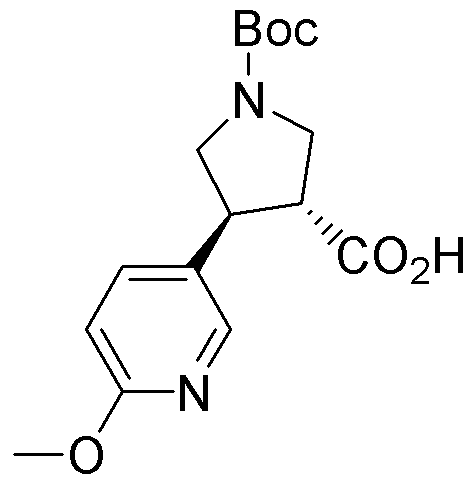Boc-(±)-trans-4-(6-methoxy-3-pyridinyl)pyrrolidine-3-carboxylic acid is widely utilized in research focused on:
- Pharmaceutical Development: This compound serves as a key intermediate in the synthesis of various pharmaceuticals, particularly those targeting neurological disorders. Its unique structure allows for the development of drugs with improved efficacy and reduced side effects.
- Biochemical Research: Researchers use this compound to study receptor interactions and enzyme activities, helping to elucidate biological pathways and mechanisms. Its specificity makes it a valuable tool in drug discovery and development.
- Organic Synthesis: It is employed in organic chemistry as a building block for constructing complex molecules. Its versatility in reactions allows chemists to create a wide range of derivatives for further applications.
- Material Science: The compound can be used in the development of novel materials with specific properties, such as enhanced thermal stability or electrical conductivity, making it relevant in fields like electronics and nanotechnology.
- Analytical Chemistry: This chemical is utilized in the formulation of analytical standards and reagents, aiding in the accurate detection and quantification of other substances in various samples, which is crucial for quality control in manufacturing processes.
General Information
Properties
Safety and Regulations
Applications
Boc-(±)-trans-4-(6-methoxy-3-pyridinyl)pyrrolidine-3-carboxylic acid is widely utilized in research focused on:
- Pharmaceutical Development: This compound serves as a key intermediate in the synthesis of various pharmaceuticals, particularly those targeting neurological disorders. Its unique structure allows for the development of drugs with improved efficacy and reduced side effects.
- Biochemical Research: Researchers use this compound to study receptor interactions and enzyme activities, helping to elucidate biological pathways and mechanisms. Its specificity makes it a valuable tool in drug discovery and development.
- Organic Synthesis: It is employed in organic chemistry as a building block for constructing complex molecules. Its versatility in reactions allows chemists to create a wide range of derivatives for further applications.
- Material Science: The compound can be used in the development of novel materials with specific properties, such as enhanced thermal stability or electrical conductivity, making it relevant in fields like electronics and nanotechnology.
- Analytical Chemistry: This chemical is utilized in the formulation of analytical standards and reagents, aiding in the accurate detection and quantification of other substances in various samples, which is crucial for quality control in manufacturing processes.
Documents
Safety Data Sheets (SDS)
The SDS provides comprehensive safety information on handling, storage, and disposal of the product.
Product Specification (PS)
The PS provides a comprehensive breakdown of the product’s properties, including chemical composition, physical state, purity, and storage requirements. It also details acceptable quality ranges and the product's intended applications.
Certificates of Analysis (COA)
Search for Certificates of Analysis (COA) by entering the products Lot Number. Lot and Batch Numbers can be found on a product’s label following the words ‘Lot’ or ‘Batch’.
*Catalog Number
*Lot Number
Certificates Of Origin (COO)
This COO confirms the country where the product was manufactured, and also details the materials and components used in it and whether it is derived from natural, synthetic, or other specific sources. This certificate may be required for customs, trade, and regulatory compliance.
*Catalog Number
*Lot Number
Safety Data Sheets (SDS)
The SDS provides comprehensive safety information on handling, storage, and disposal of the product.
DownloadProduct Specification (PS)
The PS provides a comprehensive breakdown of the product’s properties, including chemical composition, physical state, purity, and storage requirements. It also details acceptable quality ranges and the product's intended applications.
DownloadCertificates of Analysis (COA)
Search for Certificates of Analysis (COA) by entering the products Lot Number. Lot and Batch Numbers can be found on a product’s label following the words ‘Lot’ or ‘Batch’.
*Catalog Number
*Lot Number
Certificates Of Origin (COO)
This COO confirms the country where the product was manufactured, and also details the materials and components used in it and whether it is derived from natural, synthetic, or other specific sources. This certificate may be required for customs, trade, and regulatory compliance.


